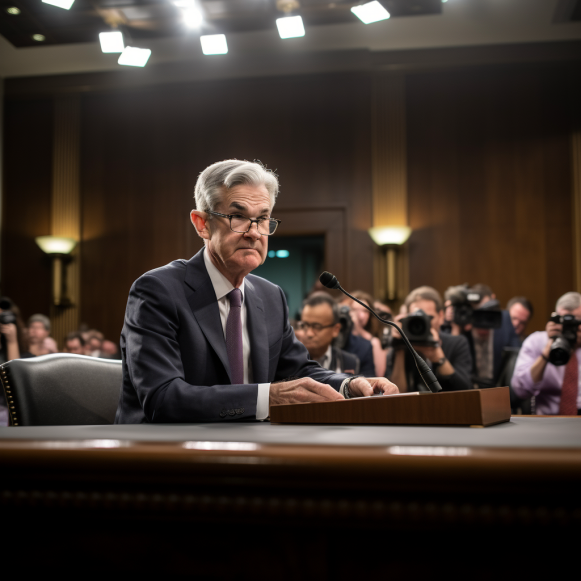The Federal Reserve just hiked interest rates to their highest level in 22 years. Here’s how Wall Street is reacting, where the pros think investors should be putting their money, and why inflation isn’t going anywhere anytime soon.

- The Federal Reserve hiked rates in July, and it could be the final rate hike of the cycle.
- Wall Street is still wary of inflation, and investors shouldn’t celebrate too early.
- The pros say investors should stay the course, and keep an eye on earnings.
On Wednesday, Federal Reserve Chairman Jerome Powell announced the 11th increase in interest rates since March 2022, in a widely anticipated move. The increase raised interest rates to a target range of 5.25% to 5.50%, the highest level in more than two decades.
For weeks, Wall Street has been pricing in a rate hike, buoyed by a better-than-expected decrease in inflation and a strong bull market rally that has seen the S&P 500 rise nearly 20% year to date.
However, while the most recent rate hike was all but certain, there are still many unknowns about what lies ahead.
Is inflation under control, or will it persist? Are policymakers satisfied, or will another increase be implemented in September?
Most importantly, how should investors position themselves to benefit from the latest monetary policy moves?
Don’t get complacent just because inflation has fallen
While a quarter-point increase in interest rates was expected, the June CPI reading, which showed inflation at 3%, was a pleasant surprise. It sparked recent speculation about the viability of a soft landing, bolstering hopes that inflation has finally been defeated.
However, Henry Allen, a macro strategist at Deutsche Bank, advises investors not to be overly optimistic. Allen pointed out a number of factors in a recent note to clients that indicate inflation isn’t going away anytime soon.
Long-term trends such as an aging population will reduce the pool of working-age adults over time, forcing wages to rise in response, as will a decline in globalization as the US focuses on re-shoring key industries, raising the cost of production.
More immediately, while lower energy prices are currently translating to lower CPI, Allen believes that this will not last — and rising energy costs will have a significant impact on inflation.
“In fact, our US economists expect the year-on-year CPI number to tick up from 3.0% in June to 3.3% in August, partly because those base effects will be rolling out of the annual comparison,” Allen wrote.
Furthermore, low unemployment means that the Fed has room to cause some economic pain in order to reduce inflation before job losses outweigh the benefits of low inflation.
“Over the last 12 cycles, the Fed has only cut rates when core CPI is above 3% and unemployment is above 5%,” Allen wrote.
Is this the last Fed hike?
Having said that, Wall Street is divided on whether the rate-hiking cycle is truly over.
Goldman Sachs chief economist Jan Hatzius noted in a note issued Wednesday evening that Powell stated that any further hikes will be dependent on inflation data. Hatzius anticipates that upcoming CPI reports will continue June’s softening trend, which is why he believes the July hike will bring the cycle to a close.
“As a result, we anticipate that the FOMC will skip September in order to slow the pace, concluding in November that inflation has slowed sufficiently to render a final hike unnecessary,” he wrote.
Indeed, Powell will have plenty of data to determine the Fed’s next move between now and the September FOMC meeting, with two more CPI reports, two more employment reports, and an ECI report.
According to Gurpreet Gill, global fixed income macro strategist at Goldman Sachs Asset Management, while the rate hike in July may be the last, it all depends on the data.
“Recent data suggest that the US policy rate will peak in July, as core CPI inflation slowed sharply in June.” However, any renewed signs of inflation strength in key data such as Friday’s Employment Cost Index and upcoming PCE inflation releases have the potential to extend the hiking path,” Gill wrote.
A team of Deutsche Bank analysts led by chief economist Peter Hooper wrote that they are confident the data will show that inflation is on the decline — but they made sure to hedge their bets.
“In particular, we continue to see today’s hike as the last of the cycle, as somewhat faster disinflation, coupled with a softening in growth and the labor market – conditions Powell noted are necessary to consider pausing – will become more evident in the coming months,” they wrote. “However, with rising prospects for a soft landing and the possibility of some inflation pick-up later this year, Fed officials are likely to be hesitant to abandon their tightening bias.”
However, Bank of America analysts led by US economist Michael Gapen remain skeptical that the rate hike cycle has ended.
“We maintain our view that the Fed has one more policy rate hike in the works and anticipate a 25bp rate hike at the September FOMC meeting for a terminal target range of 5.50-5.75%,” Gapen wrote in a client note. “Furthermore, we continue to expect the first policy rate cut in May 2024.”
How to invest after the latest Fed announcement
With inflation down but not out and the Fed’s final decision still up in the air, investors looking for advice on where to put their money should consult the experts.
In terms of fixed income, Goldman’s Gill advises investors to avoid US Treasuries.
“Because of the uncertainty surrounding the end of the Fed’s hiking cycle, we have limited exposure to US rates.” “We believe that further deflationary progress will limit the extent to which US Treasury yields rise, while a resilient labor market and economy will limit the extent to which yields can fall,” he wrote.
Bank of America’s Gapen continues to favor the dollar, at least for the time being.
“Despite the USD’s notable selloff earlier this month, we remain constructive in the short term, as broader economic resilience suggests that eventual rate cuts would likely occur later than currently priced, all else being equal,” he wrote. “While we continue to believe the dollar is overvalued in the long run, the fight against inflation in a relatively resilient economy should benefit the USD.”
In terms of equities, Wall Street widely anticipated this week’s rate hike, so there have been no significant changes to their second-half investing recommendations. In fact, the majority of their focus is on the current earnings season and how companies’ finances are faring.
In this regard, Morgan Stanley’s chief US equity strategist Mike Wilson has a word of caution: lower inflation isn’t the panacea it appears to be.
This earnings season, one key theme to watch will be whether companies in the communication services, consumer discretionary, and technology sectors can maintain their pricing power in the face of lower inflation.
“With price being the main factor that has held sales growth above zero for many companies this year, it would be a material headwind if that pricing power were to roll over,” he wrote in a note to clients. “This is exactly what we believe is happening for many businesses, particularly those focused on the goods economy.”






